If there is one issue that most of the polarized citizens of San Juan County, Utah can agree upon, it’s that very few of them want their communities to wind up like Moab, Utah.
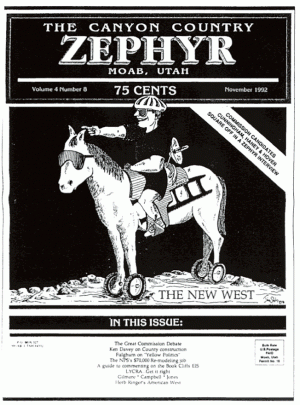 The fear of “Being the Next Moab” even grips the souls of the little community that’s already halfway there. While banking its future on the mega-contributions and tireless marketing and promotion of the outdoor industry’s corporate giants–Patagonia, North Face et al–the recently incorporated city of Bluff, Utah still insists that it can extract all the benefits of an Industrial Recreation economy and simultaneously avoid the pitfalls and impacts that have decimated almost every other community in the New West of 2018. Many Bluffites believe that good planning and zoning and a solid “sustainable” vision for the future will protect their little community from a Moab-like fate.
The fear of “Being the Next Moab” even grips the souls of the little community that’s already halfway there. While banking its future on the mega-contributions and tireless marketing and promotion of the outdoor industry’s corporate giants–Patagonia, North Face et al–the recently incorporated city of Bluff, Utah still insists that it can extract all the benefits of an Industrial Recreation economy and simultaneously avoid the pitfalls and impacts that have decimated almost every other community in the New West of 2018. Many Bluffites believe that good planning and zoning and a solid “sustainable” vision for the future will protect their little community from a Moab-like fate.
Okiedokie.
But while Bluff continues to reside in a state of delusional denial, its conservative neighbors Up North have been more blatantly opposed to a massive tourist influx. They have made those concerns the centerpiece of their opposition to the original 1.3 million acre Bears Ears NM proclaimed by President Obama in the last days of his presidency. Many still worry that the massive marketing campaigns by the outdoor industry and mainstream environmentalists could forever change their quiet communities. Blanding and Monticello do not want to be the next Moab.
But sometimes the future can sneak up on a community. The threat of a future than nobody wants can be implemented so slowly and methodically that the threat doesn’t seem serious enough to take seriously. And in this case, the story is unfolding without being noted or reported.
“…spent the day ‘grubbing out’ a 1.2 mile section of single-track mountain bike trail. The 34” wide swath will soon connect other sections of trail that will stretch from Loyds Lake to the already existing trail system at the Monticello Uranium Mill Site.
“Nearly eleven miles of single track mountain bike trail is in the process of being built. The project is funded with a grant that was secured by Monticello City two years ago, when Natalie Randall was the city recreation manager. Similar trail systems are also under consideration in the Blanding and Bluff areas.”
The article explained that the project was funded by grants obtained by Monticello City and that the trails are being designed by Moab Trail Mix’s Scott Escott. Escott has played a major role in creating and constructing hundreds of miles of bike trail in Grand County. He and a handful of other recreation industry enthusiasts have helped to transform Moab and vicinity. Now he brings his “skills” to San Juan County.
Platt wrote:
“This is the first trail system in San Juan County and is designed by Scott Escott. The foundation for Escott’s expertise comes from serving for ten years as the Trail Mix coordinator for Grand County, a group which combines resources and manpower from the Moab City, BLM and Forest Service for building mountain bike trails….Escott has also designed trails for several Utah State Parks, including Dead Horse Point, Goblin Valley, Escalante, Green River, and a proposed Goosenecks Trail that was put on hold with the designation of the Bears Ears Monument.”
DEJA VU IN MOAB
Why does none of this surprise me? Over four years ago, I wrote a long investigative piece for The Zephyr, called “Moab is Assimilated. Bike Borg Moves South.” It warned San Juan County citizens that the same forces who turned Moab into the nightmare it has become, are now looking South…and licking their chops.
In trying to predict what might happen in the future to San Juan County, I wrote this, over four years ago: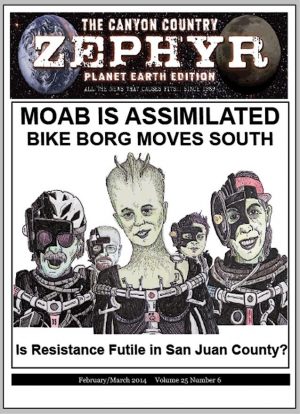
‘(If the Bike Borg Moves South), San Juan County residents might be surprised to see a new level of cooperation between the non-motorized recreation community and (public land agencies) in San Juan County.
‘At a September 2013 public meeting in Sedona, Arizona , Grand County Trail Mix trails coordinator Scott Escott bragged about his organization’s extraordinary success in constructing new single track bicycle trails on public lands near Moab. He pointed to more than a decade of work, “building trust” with the BLM. “And now we have another line of trust,” Escott proclaimed. “What Trail Mix has gained from this is that the BLM defers to us when it comes to the actual trail building. They trust us and do not question us on trail alignment and construction. This trust is the basis of our partnership.”’
‘Escott noted that their biggest critic at BLM, Katie Stevens, had observed their trail construction. According to Escott, “Katie called it the Appian Way, after the work of the ancient Romans which still exists today.” He could not have been prouder. Will that kind of enthusiasm lead to similar single-track/bike-only trails in San Juan County?’
So years later, the construction of this trail system, now on USFS lands, does not surprise me. In April 2014 the Borg story was re-printed in the San Juan Record and now appears in the current edition of San Juan County’s history magazine, “Blue Mountain Shadows.” I would hope that those who read the story then, and especially the Record’s editor, might have taken note of my warning and seen this latest trail building announcement as more than just a benign press release. Because in that story lies a big chunk of San Juan County’s future.
It’s remarkable how few people realize the extent of single-track trail building in southeast Utah. As recently as last month, when I mentioned the plethora of bike trails in Grand County, a Salt Lake City environmental activist shot back, “Moab mountain biking (is) based on a road network left over from atomic-age uranium mining.”
That might have been true a decade and a half ago, but no longer. In 2018 a massive network of single-track bike trails is being constructed at a furious pace, often with tax-payer dollars and it’s all part of a grander scheme to create the kind of Industrial Recreation Economy its most rabid proponents have dreamed of for years.
Just a year ago, a very candid article was posted on Moab’s Rim Tours web site, called “How Moab built 150 miles of single-track in just 10 years.” In the story, author and former SUWA staffer Franklin Seal explained that while Moab had been called the “Mountain Bike Capital” for many years…
“…by the early 2000’s, other mountain bike destinations, like neighboring Fruita, CO, had become famous for their newly developed singletrack trails, and leaders of Moab’s mountain bike community knew they had to do something to keep up..”
The mountain bike industry found a willing accomplice in the BLM. But the fact is, as stated in the article, the new trails were built to help boost what enviropreneurs saw as a flagging mountain bike economy. They simply wanted to bring MORE people and more tourist dollars to the area. And their plan worked–look at Moab today.
Take the time to read the Rim Tours story. Seal explains how, “the sagebrush rebellion-inspired debate over the fate of Utah’s federal lands, made any thought of creating brand new trails, or converting motorized routes into non-motorized routes, difficult…” Biking enthusiasts feared that their trail system would never happen. But the article continues:
“Happily for Moab and the mountain biking world, cooler heads prevailed. In December of 1999, with leadership from the Grand County Council and the City of Moab, and representation from all the relevant public land agencies and recreational user groups (motorized and non-motorized,) a new committee was created and started holding meetings open to the public. It was called Trail Mix.
“2007 was a watershed year for Trail Mix. It included the submission for public comment of the Non-Motorized Trail Mix Master Plan (approved in April 2008)….After that, it was as if the singletrack ‘flood gates’ were opened.”
The Grand County Council included Kim Schappert who came to Moab in the late 80s. She was the co-founder of “Mountain Bike” magazine and early on advocated for a recreation economy-driven agenda for Grand County; on the Moab city council, Kirstin Peterson, the owner of Rim Tours, likewise shared Schappert’s vision to transform Moab.
Escott called that period, “kind of the start of the ‘Bridge of Trust’ with the BLM.” He told author Franklin Seal that, ‘When the RMP came out, it said, ‘Here’s 150 miles of mountain bike trails, and we’ll be your partners,’ ” Seal reported that the partnership between BLM and the bikers generated a lot of government support.
Escott explained to Seal that, “I think what a lot of people don’t realize (is that the BLM) supply for us archaeology, paleontology, they write the EAs, if we have wildlife issues, soil issues, they build us parking lots. If I need a bobcat or a bulldozer or whatever, they’re there for us. They are our partner because we are fulfilling that RMP (Resource Management Plan).”
* * *
Escott is right. The BLM does provide all those services for this special interest group and they are indeed fulfilling the mandate of the Resource Management Plan. Political activists like Schappert sought public office, won, and used that influence to pursue and fulfill their agendas—in this case, to create a vast network of bike trails and associated infrastructure–at a cost of millions and millions of dollars.
The web site cbklunkers.com honored Schappert several years ago, inducting her into its “hall of fame.” They reported in part that:
Kimberly would be elected to the Grand County Council where she became the first public figure to advocate for bicycling in Moab. While in office she formed Trail Mix, an advisory committee to the County Council made up of various trail users working to improve the non-motorized recreational and transportation opportunities throughout Grand County.
Eight years later Trail Mix… has many success stories to brag about including the writing and adoption of the Grand County Non-Motorized Trails Master Plan and the development of many new trails.
And the web site noted that as Executive Director for the Moab Trails Alliance, “a non-profit she helped to form in 2003, she works tirelessly writing grants, doing land management liaison work, coordinating projects with Trail Mix and baking cookies to keep work crews as psyched as she is about the effort Moab is making to maintain its reputation as a mountain biking mecca.”
BACK TO MONTICELLO…2018
That’s why this latest development, the plan to create a new single-track system in San Juan County, should be setting off alarms everywhere. THIS IS HOW IT REALLY STARTED IN MOAB, and as author Seal noted…it only took ten years.
I can honestly and with great regret say that when it came to reporting those changes in Moab, The Zephyr and I really dropped the ball. In the early 2000s, I recall hearing that the new Grand County Councilwoman Kim Schappert had big plans for Moab’s recreation infrastructure and we even discussed it briefly during her campaign. The political ad that Schappert ran in The Zephyr reflected our serious differences of opinion. In her political promo, she proclaimed:
“Unlike the publisher of The Zephyr, I am optimistic about Grand County’s Future.”
It was certainly a fair assessment of our divergent visions for Moab, and a couple years later, I packed up and moved to Monticello. I continued to hear reports of bike trail building–legal and illegal–especially from one US Forest Service source, but I failed to act. Reporting the ongoing and frenetic construction of these trails may have made no difference whatsoever, but looking back I wish I had tried harder to keep Grand County citizens informed of what was happening under their very noses.
In fact, when construction began on the multi-million dollar “elevated bikeway” in 2013, I contacted the BLM to ask about environmental assessments and efforts to involve the public in the process. The BLM’s Katie Stevens informed me that there had indeed been an EA and a public comment period—in 2004—more than eight years earlier, and that no one commented. No one. THAT’s how projects like this succeed. Apathy.
Now, as the same forces who pushed to transform Moab and Grand County into an Industrial Recreation Hub turn their sights on San Juan County, I hope government leaders, the local media, and the county’s citizens keep a close eye on this potential bombshell.
Here are some questions to ask…
* Whose idea was it to pursue a network of bike trails near Monticello?
* Who decided this trail system should extend to Bluff and Blanding?
* Did Monticello City initiate an invitation to Moab Trail Mix’s Scott Escott to discuss trails? or did he make first contact?
* Have other recreation activists contacted Monticello’s Department of Parks and Recreation or San Juan County’s Department of Economic Development and Visitor Services, such as the non-profit “Public Lands Solutions?” Four years ago, its executive director Ashley Korenblat made a presentation to the San Juan County Commission to promote an industrial tourism agenda. Is that organization involved? Has the Moab Trails Alliance been in touch with San Juan County?
* When Natalie Randall applied for grants to fund bike trail expansion, are such requests proved in advance by the Monticello City Council or do department heads have autonomy to pursue funding like this without oversight?
* Now that Ms. Randall works for the county, can she likewise pursue grants and funding for more bike trails without the consent of the commission, or must she advise them of her agenda?
* Do the trails being currently constructed stay within the city limits of Monticello? If not, how can city funds be used in the county without approval by the county commissioners?
* The article states that plans for trails in other parts of the county are underway. With whom have the trail builders discussed these plans and do they already have approval to proceed?
* And if they do have the authority to continue their trail building, how will the construction of these trails be funded? Will the taxpayers of San Juan County find themselves contributing to a massive bicycle trail system that many of the county’s residents don’t want in the first place?
* Should there be some kind of collaborative effort by the local, state and federal governing bodies to determine the cumulative effect of these trails? In the early 2000s, politicians like Schappert worked closely with BLM and other federal authorities to include 150 miles of single-track trail into their 2008 Resource Management Plan (RMP). Is a similar provision the unspoken goal in San Juan County? But to do it one piece at a time?
I believe these are fair and honest questions and I hope an effort will be made by the San Juan Record and others to find the answers. I could only locate two previous articles in the SJR, both 2016 press releases by the city of Monticello, that mention the current single-track construction. Since the author of the SJR story about the new singletrack trails is the spouse of Andy Platt, the business coordinator at San Juan County Economic Development and Visitor Services, that information should be fairly simple to acquire. Natalie Randall, who acquired the trail grants when she was director of Monticello Parks and Recreation is now the director at SJC Economic Development and Visitor Services.
But Randall is also the co-owner, with her husband, of Roam Industry. According to their web site:
“Roam Industry is to be the focal point of human powered outdoor adventure in San Juan County, Utah. By offering the best in gear, activity, remote accommodations, and services. Our mission…is to be the leading source in backcountry adventure as well as wilderness skills and education in San Juan County Utah. Our hope is to be a source to clients we bring to the area as well as the local community.”
* * *
Ultimately it may well be that San Juan County embraces full-fledged Industrial Tourism as the solution to its economic woes. I believe it will change the way of life for almost all of its residents in ways that most of them will later come to loathe. But the citizens must be the ones leading themselves to the future, not a relative handful with a hidden agenda. The only way the citizens can make those choices is to be privy to all the facts. They can’t make honest and intelligent decisions without them.
Many San Juan residents feel that the Bears Ears National Monument proclamation would cause an avalanche of tourists and investors to the area, and the numbers of tourists has already jumped dramatically in a year. The investors, the ones who make tourism profitable, are always looking for the ‘recreation hook,’ the must-see activity, the iconic formation, or the “adventure they can’t find anywhere else’ —the enticement to make the tourist dollars flow.
This beginning of a massive singletrack system is San Juan County’s Trojan Horse—on wheels–and if you’re not alert and prepared to fight it, the Trojan Horse is going to run right over what’s left of rural San Juan County and leave you wondering how all this happened, in the relative blink of an eye.
Jim Stiles is Founder and Co-Publisher of the Canyon Country Zephyr.



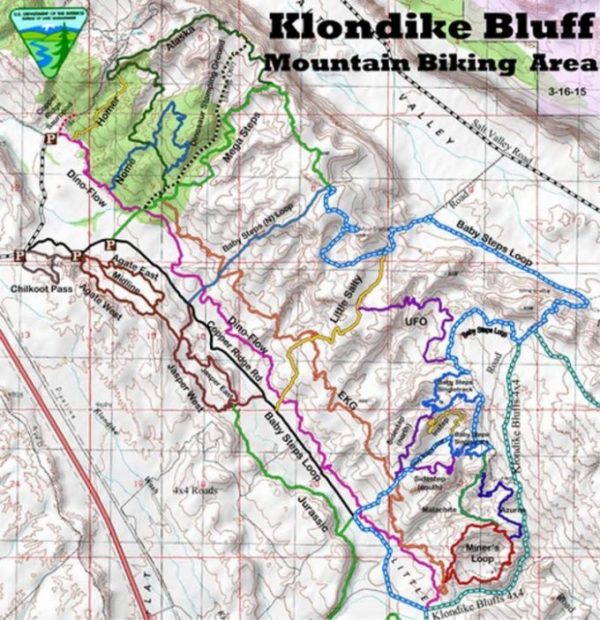

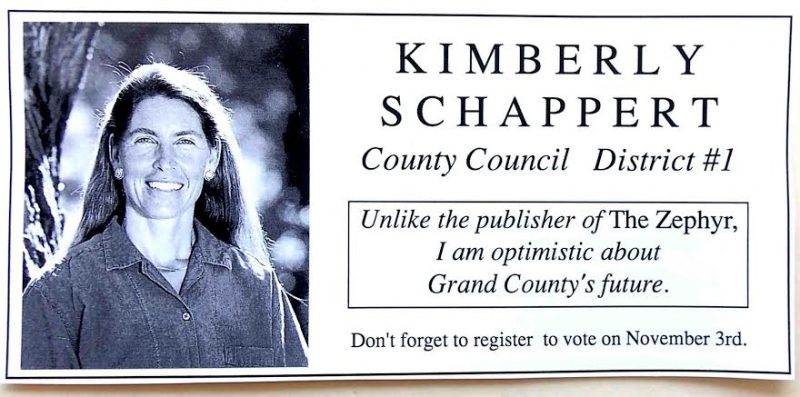
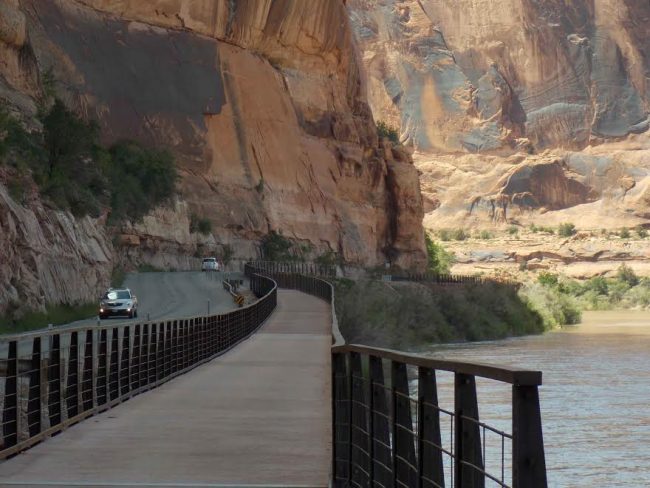
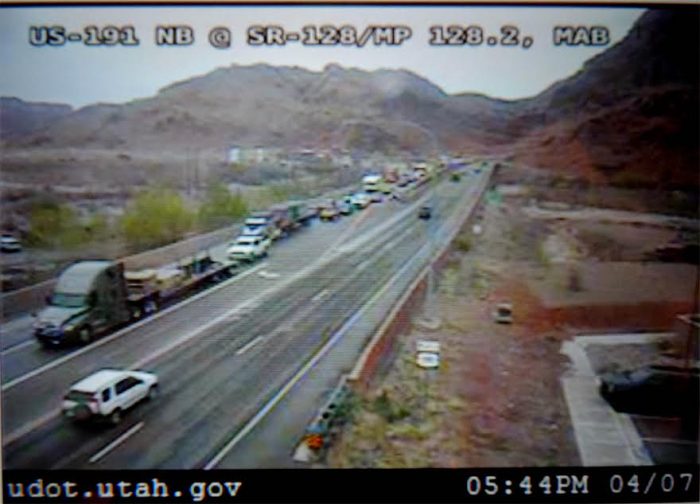



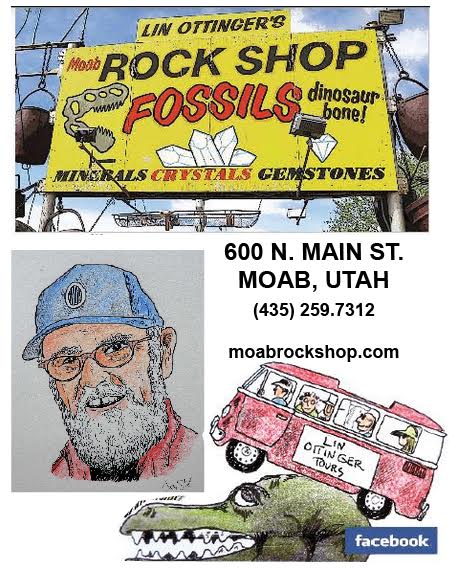

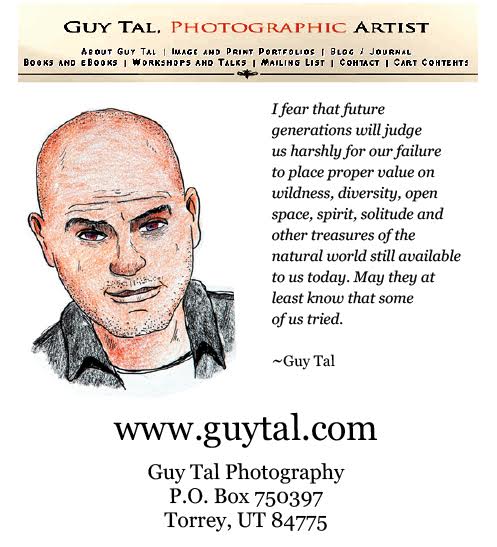
Just wait until the e-bike riders begin to make their impact. Anyone can rip it up on these:
Take Trek’s “Powerfly LT 9.7 Plus” at $5,999.99 . . . “a carbon electric mountain bike with long-travel suspension and a high-end parts spec. This high-performance e-MTB is built to take you into the wild unknown to rip up and down whatever mountains you’ll find. The OCLV Carbon frame fully hides the battery for clean looks and protection on rugged trails. Color / Dnister Black/Rage Red ”
Make no mistake: These guys are motorbikes.
An excellent, well thought out article that should be of concern to all San Juan residents who treasure access to solitude and high quality of life. I have heard some residents say that they want more economic opportunities in the county. Be careful what you wish for. Growth, whether centered on biking, hiking or other means will change what we all love about this place. We would all do well to heed this warning delivered logically and passionately by one who has travelled this road.
Your article on bike trails and hiking trails in San Juan county and the towns in the county along with your attack on Natalie Randall are very misleading. Trail work in San Juan county has been something the citizens of this county have been working on for over a decade. Natalie Randall is not acting on her own agenda like you imply. I have been involved with this issue for over 10 years along with all the county commissioners, city managers and most of the city council members from Blanding and Monticello. All of them have expressed an interest in developing multiple trail systems. Natalie has a lot of support from the towns and San Juan county on this issue. I sorry but you have really gone to far in your personal attack on a person that has been asked by elected officials to do a job assign to them. Natalie Randell has done more to help the people of San Juan county in a week than most of us do in a life time. Why don’t you take time to attend some of these meetings and find out the facts instead of coming up with your own agenda Jim.
Mr. Haven…please show the specific text from my article where i “personally attacked” Ms Randall. I have no “agenda” other than publishing information that San Juan County citizens will not find in their local newspaper. But since you have a personal vested financial interest in the tourist industry in the county, it would seem like “agenda” might better describe yourself. Cheers.
Well thought out article? I beg to differ, though it’s late as I am writing this so my thoughts may not be well thought out either. 11 miles of trial being built on F.S. land? Nope it’s all on city property. Believe it or not people like to ride bikes, even people in Monticello (heck all over the world!). Nice well planned trails make it safe and more enjoyable. Why is it sinister to have a professional trail builder (Scott) design it? I want to ride good trails not crap. What is this force in Moab? Citizens of all ages have gotten together and formed our own group without any Moab puppet master, we ride at 6 p.m. every Thursday come check it out! Biking has been on the rise across the United States for years. In San Juan county ( largest in the state) there is not one trail that is not multi use. I also repeat there are no mountain bike trails currently being built on F.S. land. Massive single track being built? I would love to hear about it. Last of all if you really want to know the truth/details call Natalie and her office up, they would love to talk details. Call me as well, shoot come by the store front we are opening. Just because people like to ride bikes and want a well thought out and safe trail system to do it on does not mean we are pulling to be another Moab. Jim I read your book (Brave New west) some crap in there ( just my opinion) but to be honest I agreed and enjoyed 95% of it, and would love to talk sometime!
I originally posted these comments yesterday on a related facebook page, in response to continued complaints by Mr. Bill Haven. I re-post them here…
* * *
I knew Bill Haven’s name sounded familiar. Four years ago, he attacked an article I wrote in The Zephyr called, “Moab is Assimilated. Bike Borg moves South.” His comments appeared in the February 12, 2014 issue of the SJR. The same article he took exception to was just re-printed in “Blue Mountain Shadows,” San Juan County’s historical magazine.
At the time, Haven accused me of being against ALL forms of economic activity. And he even embraced the efforts of Ashley Kornblat, of Moab, who was a driving force in Moab’s stunning transformation to a recreational mecca/pest hole.
Haven praised Kornblat and “gave her credit for organizing businesses and getting involved in the public lands debate.” Yes, she certainly did that. I don’t think many Stewards of San Juan regard Ashley as a fierce ally in defending San Juan County.
In my reply to Haven, a week later in the SJR, I acknowledged that 15 years ago, “opposing all forms of energy production while supporting a tourist industry—that by definition demands the massive consumption of energy simply to survive—was shamefully hypocritical.”
I was a hypocrite. Recently, I further addressed my own personal shortcomings in an article called, “Standing in the other mans shoes.”
http://www.canyoncountryzephyr.com/2017/10/03/standing-in-the-other-mans-shoes-part-1-an-overdue-sequel-to-its-time-to-look-in-the-mirror-by-jim-stiles/
But regarding his recent comments, first, I don’t have a problem at all with a few bike trails around Monticello. Eleven miles, all near town? No worries. But the article inferred that the planned trail system was MUCH grander than that. And when I saw that the same bike trail architect who engineered Grand County’s 200 MILE system ( and growing), was involved in this project, with the promise of more to come, I was concerned.
Second, I’d like Mr Haven to post the specific text from my article where I “personally attacked” Ms Randall. I have no “agenda” other than publishing information that San Juan County citizens will either not find in their local newspaper (or will fail to realize that it’s been included as a seemingly benign press release).
Many issues in this county deserve serious scrutiny and analysis and discussion by the local media. All I did was to provide hard facts that very few people were previously aware of. Like I said in my reply to Mr Haven in 2014, “What the citizens of San Juan County do with that information is entirely up to them.”
The only part of his rant that I take very personally is the idea that I’m just trying to pull more visitors to the Zephyr web site. To what end? For profit?
My principled stand on Industrial Strength Tourism has cost me thousands of dollars in advertising losses and is the reason why I had to end the print version of The Zephyr a decade ago. I could no longer in good conscience allow my publication to be funded by the massive recreation industry that has consumed Moab. And it’s fair to note that they really didn’t want to have anything to do with me either, since my views on Industrial Tourism have been pretty consistent for almost two decades.
So the difference in my agenda and Mr. Haven’s is that he does have a personal vested financial interest in the tourist industry in San Juan County, and I don’t. If I were similarly motivated, I’d be singing the praises of Patagonia, SUWA and the Outdoor Industry and raking in the big advertising bucks. I choose NOT to take that path.
Again, I support locally-owned, grassroots tourism and it almost seems odd that Haven takes such angry and persistent exception to my views. But he doesn’t seem to understand how quickly a local economy can be consumed by the corporate outdoor industry unless he doesn’t find that Future all that alarming. I’m sure he would find plenty of allies in Bluff.
It took about 20 years for Moab to be devoured. It didn’t happen overnight. But it did happen. To dismiss the possibility of it occurring in San Juan County is EXACTLY what most Moabites did as well…twenty years ago.
I live in Moab, work out of my house and in my spare time I do typical Moab activities like walking my dog under the radio antenna, camping at the end of dirt roads, hanging out by the river.
Maybe mountain bikers outnumber participants of motorized recreation, but the effect on me and my daily doings is like night and day. The impact of the latter group is abusively overwhelming. The noise, smell and sheer physical size of the equipment pared with the frequent postulating antics of the users takes all attention away from hikers, base jumpers, river runners, mountain bikers, Park visitors, and all the other tourists coming here.
If you all down there in SJC wants to preserve a notion of quiet city life you need to rise a solid middle finger into the face of anyone entertaining the thought of opening a Razor rental business within city limits.
Thanks, Jim for the time, effort, and research you have done to try and bring to light to one of the vital issues facing San Juan County. There are so many red flags that you have pointed out that I don’t even know where to begin or where to end.
Hello from the northeast. I found your article searching “rail trails: the energy industry’s new trojan horse”. I am wondering if any research has been done to lok at the land use agreements governing the trails? I am finding here that recreational trails are considered “public ways” similar to roads, and as such, are controlled by the state departments of transportation who often execute land use and maintenance agreements with mountain biking groups that protect the state’s rights to allow “other uses” along the trails. And, often we are finding utility companies will lease the right to bury transmission/distribution infrastructure under the trails. In addition, the government agency retains the right to use the right-of-ways for passenger rail, or light freight in the future. Gas pipelines fall under “light freight” as they move product. Rail beds are targeted due to their straight, flat design, and due to their ability to connect community centers. Developers, bankers, realtors, and utility companies benefit from the expansion of such infrastructure as they do not have to pay to construct the rights-of-way, federal tax dollars pay for 80% of it, and local matches from property taxes make up the remaining 20%. Volunteers donate time and money to the effort, and mountain bike, snowmobile and ORHV groups agrre to maintain the trails. The utility companies also are able to bypass the state’s Public Utility Commission’s siting review as the right-of-way already exisits and is controlled by the state. The new utility infrastructure; whether it be fiber optic cables, internet, water, sewer, electricity, or gas, are welcomed by the local and county agencies who are focused on economic development, and whose boards are often made up of business owners and contractors who will benefit from the growth. Articles about these public-private partnerships can be found on the Rails-To-Trails Concervancy website. The “trojan horse” analogy came to mind as the regional planning commissions create the “trails plans” and “help towns” draft changes to their Madter Plans, based on trail routes they want to see constructed. The trails are promoted to the voters as recreational infrastructure and support for them is gained, including volunteering time and money to help build them. The utility companies can then use them without having to go through the political red tape normally required when rights-of-way need to be constructed across private lands, the trail is a state-owned right of way. The local property owners are asked to support a recreational trail but are not told of the potential for “other uses” they may not be supportive of. And bike trail supporters are then tasked with helping to win over property owners aling the trail. But no one is talking about the sweetheart deals being made between the state, county and local agencies who collect the lease fees and property taxes from the utility companies, and the utltity companies eho are saving millions in applications, siting approvals, construction, and legal fees associated with emminent domain lawsuits, maintenance costs of the rights-of-way. It is not happening in every case, but if the land use agreement includes “other uses”, it could. It all seems very sneaky, and likely illegal, as it uses private tax revenue to pay for corporate utility infrastructure.